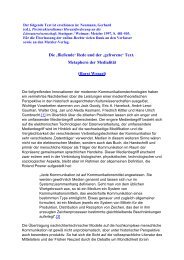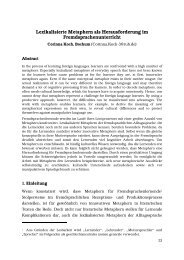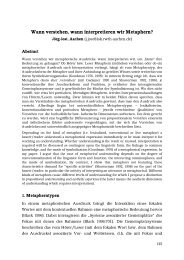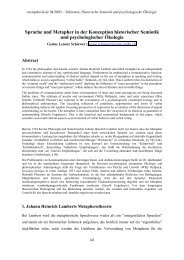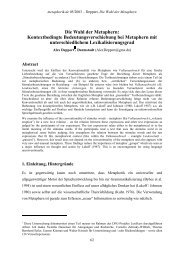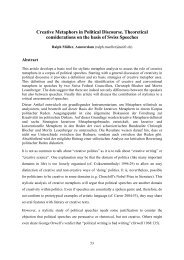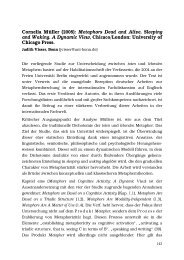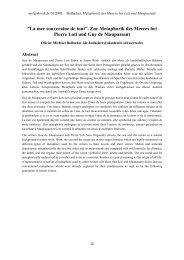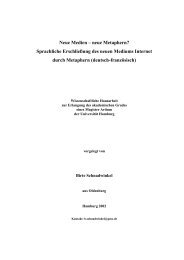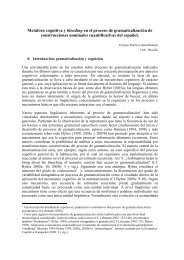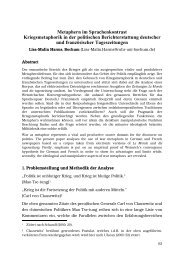Olaf Jäkel (jaekel@anglistik.uni-halle.de) - metaphorik.de
Olaf Jäkel (jaekel@anglistik.uni-halle.de) - metaphorik.de
Olaf Jäkel (jaekel@anglistik.uni-halle.de) - metaphorik.de
You also want an ePaper? Increase the reach of your titles
YUMPU automatically turns print PDFs into web optimized ePapers that Google loves.
<strong>metaphorik</strong>.<strong>de</strong> 02/2002 - <strong>Jäkel</strong>, Cognitive Theory of Metaphor Applied to Religious Texts<br />
Hypotheses Revisited: The Cognitive Theory of Metaphor Applied<br />
to Religious Texts<br />
Abstract<br />
<strong>Olaf</strong> <strong>Jäkel</strong> (<strong>jaekel@anglistik</strong>.<strong>uni</strong>-<strong>halle</strong>.<strong>de</strong>)<br />
The main tenets of the Cognitive Theory of Metaphor are summarized in the form of nine hypotheses (cf. <strong>Jäkel</strong><br />
1997). Then, instances of the JOURNEY metaphor with its un<strong>de</strong>rlying PATH schema from the latest English<br />
version of the Bible are analyzed by way of a semasiological approach. The findings of this empirical case study<br />
are finally brought to bear on the theoretical claims. While as a result most of these tenets are seen to be<br />
corroborated, the "invariance hypothesis" (cf. Lakoff 1993) in particular appears highly suspect.<br />
Die Kernaussagen <strong>de</strong>r Kognitiven Metapherntheorie wer<strong>de</strong>n in Form von neun Hypothesen zusammengefasst<br />
(vgl. <strong>Jäkel</strong> 1997). Darauf wird in einem semasiologischen Ansatz die REISE-Metaphorik mit <strong>de</strong>m zugrun<strong>de</strong><br />
liegen<strong>de</strong>n WEG-Schema in <strong>de</strong>r neuesten englischen Bibelübersetzung analysiert. Die Erkenntnisse dieser<br />
empirischen Fallstudie wer<strong>de</strong>n schließlich zur Überprüfung <strong>de</strong>r Theorieaussagen verwen<strong>de</strong>t. Während in diesem<br />
Licht die Thesen mehrheitlich als bestätigt gelten können, erscheint insbeson<strong>de</strong>re die "Invarianzhypothese" (vgl.<br />
Lakoff 1993) hochgradig suspekt.<br />
Introduction<br />
With respect to metaphors in religious contexts, a cognitive-semantic approach after the<br />
manner of Lakoff and Johnson can provi<strong>de</strong> valuable insights. 1 The overall aim of this essay is<br />
to exemplify both prospects and limitations of the Cognitive Theory of Metaphor in <strong>de</strong>aling<br />
with religious metaphor. In the first section, a refined framework of the cognitive approach to<br />
metaphor (see <strong>Jäkel</strong> 1997) is given in summary (section 1.1.), before we <strong>de</strong>rive certain<br />
predictions about the occurrence, frequency, and conceptual characteristics to be expected of<br />
linguistic metaphors in discourse or texts <strong>de</strong>aling with religious issues (1.2.). The section<br />
closes with a short explanation of the theoretical focus of the investigation (1.3.).<br />
The main section (2.) of this paper is <strong>de</strong>voted to the conceptual analysis of metaphors taken<br />
from the Judao-Christian tradition of the Bible, in particular the Old Testament. All linguistic<br />
examples are quoted from the latest English translation (1995) The Holy Bible: New Revised<br />
Standard Version, Anglicized Edition. I take a semasiological approach to the data, singling<br />
out instances of the JOURNEY metaphor. 2 In the final section (3.), the findings of this<br />
empirical case study are brought to bear on the central tenets of the theory of metaphor (3.1.).<br />
The so-called "invariance hypothesis" receives particular attention (3.2.) in a final comparison<br />
1<br />
A heartfelt thank-you goes to James Francis whose <strong>de</strong>tailed comments on an earlier draft saved me from some<br />
major (theological) pitfalls. All remaining errors etc. pp.<br />
2<br />
The distinction of an onomasiological versus a semasiological approach in the analysis of metaphor was<br />
introduced by Weinrich (1958:284). For a comprehensive discussion of Weinrich's merits as a pre<strong>de</strong>cessor of<br />
the Cognitive Theory of Metaphor see <strong>Jäkel</strong> (1999b and 1997: sections 4.4. and 5.1.)<br />
20
<strong>metaphorik</strong>.<strong>de</strong> 02/2002 - <strong>Jäkel</strong>, Cognitive Theory of Metaphor Applied to Religious Texts<br />
of the sublime uses of the JOURNEY metaphor in religious contexts with its conventional<br />
applications in profane discourse.<br />
1. The Cognitive Theory of Metaphor and Religious Discourse<br />
In the following, the main tenets of the Cognitive Theory of Metaphor are summarised in the<br />
form of nine hypotheses. For a more comprehensive introduction of these tenets and a <strong>de</strong>tailed<br />
discussion of problems associated with the cognitive approach to metaphor see <strong>Jäkel</strong> (1997).<br />
1.1. Nine Central Tenets of the Cognitive Theory of Metaphor<br />
(1.) Ubiquity Hypothesis<br />
Linguistic metaphor is not an exceptional matter of poetic creativity or excessive rhetoric. In<br />
perfectly ordinary everyday language (as well as in highly specialised expert discourse),<br />
conventional metaphors are abundant. Therefore, linguists have to face the task of accounting<br />
for them as part of our general linguistic competence.<br />
(2.) Domain Hypothesis<br />
Most metaphorical expressions are not to be treated in isolation, but as linguistic realisations<br />
of conceptual metaphors: These consist in the systematic connection of two different<br />
conceptual domains, one of which functions as target domain (X) with the other supplying the<br />
source domain (Y) of the metaphorical mapping. In this manner, X is conceptualised as Y,<br />
one conceptual domain is un<strong>de</strong>rstood by taking recourse to another domain of experience.<br />
(3.) Mo<strong>de</strong>l Hypothesis<br />
Quite often, conceptual metaphors form coherent cognitive mo<strong>de</strong>ls: complex gestalt structures<br />
of organised knowledge as pragmatic simplifications of an even more complex reality. These<br />
i<strong>de</strong>alized cognitive mo<strong>de</strong>ls (ICMs), which can be reconstructed by means of cognitive<br />
linguistic analyses of everyday language, are regar<strong>de</strong>d as cultural mo<strong>de</strong>ls likely to<br />
unconsciously <strong>de</strong>termine the world view of a whole linguistic comm<strong>uni</strong>ty.<br />
(4.) Diachrony Hypothesis<br />
Cognitive-semantic studies of metaphor show that even in the historical <strong>de</strong>velopment of<br />
languages, most metaphorical meaning extensions are not a matter of isolated expressions, but<br />
provi<strong>de</strong> evi<strong>de</strong>nce of systematic metaphorical projections between whole conceptual domains.<br />
Therefore a cognitive approach to metaphor can benefit from the integration of the diachronic<br />
dimension.<br />
(5.) Unidirectionality Hypothesis<br />
As a rule, metaphor ("X is Y") links an abstract and complex target domain (X) as<br />
explanandum with a more concrete source domain (Y) as explanans, which is more simply<br />
structured and open to sensual experience. In this connection, the relation between the<br />
21
<strong>metaphorik</strong>.<strong>de</strong> 02/2002 - <strong>Jäkel</strong>, Cognitive Theory of Metaphor Applied to Religious Texts<br />
elements X and Y is irreversible, the metaphorical transfer having an unequivocal direction.<br />
This <strong>uni</strong>directionality of metaphor is found both synchronically and diachronically.<br />
(6.) Invariance Hypothesis<br />
In conceptual metaphors, certain schematic elements get mapped from the source domain onto<br />
the target domain without changing their basic structure. These preconceptual imageschemata<br />
provi<strong>de</strong> the experiential grounding of even the most abstract of conceptual domains.<br />
(7.) Necessity Hypothesis<br />
In general, metaphors have an explanatory function. Certain issues could hardly be un<strong>de</strong>rstood<br />
or conceptualised at all without recourse to conceptual metaphor. Abstract conceptual<br />
domains, theoretical constructs, and metaphysical i<strong>de</strong>as in particular are only ma<strong>de</strong> accessible<br />
to our un<strong>de</strong>rstanding by means of metaphor. Through relating even the most abstract<br />
conceptual thinking to sensual perception, conceptual metaphors supply a bodily, biophysical<br />
grounding of cognition, providing coherence and <strong>uni</strong>ty of our experience.<br />
(8.) Creativity Hypothesis<br />
The potential meaningfulness of metaphor does not yield to simple paraphrase, its meaning<br />
cannot be reduced to a nonmetaphorical, propositional format without loss. This is the reason<br />
for the enormous creativity that metaphor displays not only in poetic discourse: In ordinary<br />
everyday life it can restructure ingrained patterns of thinking. And in scientific contexts it can<br />
have a heuristic function.<br />
(9.) Focussing Hypothesis<br />
Metaphors only supply a partial <strong>de</strong>scription or explanation of the target domain in question,<br />
highlighting certain aspects while hiding others. It is this focussing that makes the difference<br />
between alternative metaphors for the same target domain.<br />
Taken together, these nine hypotheses form the gist of a refined Cognitive Theory of<br />
Metaphor. Not all of them will be of the same concern to the following investigation. Thus,<br />
hypotheses (4.) and (9.) will be largely disregar<strong>de</strong>d as the metaphor study neither inclu<strong>de</strong>s<br />
diachronic investigations nor compares the different focussing effects of alternative mo<strong>de</strong>ls. 3<br />
More central to the present piece of research are hypotheses nos 2, 3, 5, 6, and 7, as explained<br />
in the following section.<br />
1.2. General Predictions Concerning Religious Discourse<br />
Relying on this theoretical framework, we can make certain predictions about the occurrence,<br />
frequency, and centrality of linguistic metaphors in discourse or texts <strong>de</strong>aling with religious<br />
3 But see <strong>Jäkel</strong> (1997) for case studies in metaphor analysis including these dimensions neglected here.<br />
22
<strong>metaphorik</strong>.<strong>de</strong> 02/2002 - <strong>Jäkel</strong>, Cognitive Theory of Metaphor Applied to Religious Texts<br />
issues. We may further be able to predict some of the conceptual characteristics to be expected<br />
from those metaphors.<br />
According to the necessity hypothesis (7.), the domain of the religious should be largely if not<br />
completely <strong>de</strong>pen<strong>de</strong>nt on metaphorical conceptualisation. It is not only a highly abstract<br />
domain quite removed from sensual experience, 4 but its central issues of God, the soul, the<br />
hereafter, and the freedom of moral choice have traditionally been regar<strong>de</strong>d as the<br />
metaphysical i<strong>de</strong>as par excellence. 5<br />
That our conceptualisation of metaphysical i<strong>de</strong>as is in principle of a metaphorical nature has<br />
been observed by philosophers working in epistemology as well as by philosophers analysing<br />
metaphor. A paragon of the first kind is Kant, 6 major protagonists from the second group are<br />
Blumenberg 7 and Johnson (1992:362). The same or similar observations have been ma<strong>de</strong> by<br />
theologians and Bible commentators from as early as the sixth century, particularly concerning<br />
the conceptualisation of God. 8 To conclu<strong>de</strong> with this most general prediction: Religious<br />
discourse should abound with metaphorical expressions.<br />
According to the domain hypothesis (2.), these metaphorical expressions should display<br />
enough systematicity to be accounted for in terms of conceptual metaphors. Moreover – as<br />
expressed in hypothesis (3.) – these conceptual metaphors might even form coherent cognitive<br />
mo<strong>de</strong>ls.<br />
Due to the <strong>uni</strong>directionality hypothesis (5.), the metaphorical source domains revealed by<br />
conceptual analysis should in principle be of a concrete kind, open to experience through the<br />
senses. Of course, the hypothesis would also exclu<strong>de</strong> a reversal of the direction of transfer,<br />
with the domain of the religious functioning as source domain. 9<br />
As for the question of what gets mapped in the metaphorical transfer to the target domain of<br />
religious i<strong>de</strong>as, the invariance hypothesis (6.) suggests image-schemata as the privileged<br />
structural elements from the concrete source domains in question.<br />
4<br />
For metaphor studies of other abstract domains see <strong>Jäkel</strong> (1997); cf. <strong>Jäkel</strong> (1993, 1994 and t.a.) on<br />
ECONOMY, <strong>Jäkel</strong> (1995) on THE MIND, and <strong>Jäkel</strong> (1996) on SCIENCE.<br />
5<br />
Cf. for example the seminal treatment in Kant (1781/87).<br />
6<br />
Cf. in particular Kant (1790:§ 59) for the general observation, and see his discussion of the metaphor of GOD'S<br />
CREATION AS A WORK OF ART in (1781/87:B 655, 1783:§ 57 and 1790:§ 90). For a comprehensive<br />
introduction to Kant's contributions as a pre<strong>de</strong>cessor of the Cognitive Theory of Metaphor see <strong>Jäkel</strong> (1999b<br />
and 1997: section 4.2.).<br />
7<br />
See Blumenberg (1960 and 1971). For a comprehensive discussion of Blumenberg as a pre<strong>de</strong>cessor of the<br />
Cognitive Theory of Metaphor cf. <strong>Jäkel</strong> (1999b and 1997: section 4.3.).<br />
8<br />
Cf. Boeve & Feyaerts (1996) as well as Platzner (1996), whose formulation (1996:9) is that "even the most<br />
intricate of metaphoric constructions cannot bridge the cognitive distance between language and divine<br />
reality."<br />
9<br />
Cf. <strong>Jäkel</strong> (1999a) for an empirical test of the <strong>uni</strong>directionality hypothesis by means of investigating the<br />
un<strong>de</strong>rstanding of metaphorical expressions.<br />
23
<strong>metaphorik</strong>.<strong>de</strong> 02/2002 - <strong>Jäkel</strong>, Cognitive Theory of Metaphor Applied to Religious Texts<br />
After our cognitive-semantic analysis in the main section (2.) we will (in section 3) come back<br />
to look at these predictions and the central tenets of the Cognitive Theory of Metaphor in the<br />
light of the empirical evi<strong>de</strong>nce.<br />
1.3. The Focus of the Investigation<br />
Well-known conventional metaphors conceptualise God as father, lover, shepherd, craftsman,<br />
employer, landowner, lord, king, or judge. 10 The sheer number and pervasiveness of<br />
metaphors like these in religious discourse might be taken as a first confirmation of our<br />
hypotheses of necessity and <strong>uni</strong>directionality.<br />
If the following study does not <strong>de</strong>al with any of these in particular, this is because these<br />
metaphorical "names of God" seem less interesting in respect of theoretical consi<strong>de</strong>rations.<br />
For one thing, most of these "names" do not come from source domains that comprise clearly<br />
<strong>de</strong>lineated image-schemata. My intention to inclu<strong>de</strong> a test of the invariance hypothesis ma<strong>de</strong> it<br />
necessary to look for other metaphors from the domain of the religious.<br />
The solution of focussing on JOURNEY metaphors seemed to be advantageous in more than<br />
one respect. Besi<strong>de</strong>s conceptualising interesting aspects of the target domain, like the i<strong>de</strong>a of<br />
the good life, moral choice, hope, and the relation between God and human beings, the source<br />
domain JOURNEY has at its heart one of the most clearly <strong>de</strong>lineated of image-schemata: the<br />
PATH schema. A brief outline of this conceptual building block may be in place here.<br />
The PATH schema (alternative labels: SOURCE-PATH-GOAL schema, MOTION schema)<br />
has been <strong>de</strong>scribed in <strong>de</strong>tail in cognitive-semantic literature. 11 It is one of the most pervasive<br />
of image-schemata with a firm experiential grounding. Its basic structure inclu<strong>de</strong>s a starting<br />
point or SOURCE of motion, the PATH traversed, and a GOAL. This simple basic structure<br />
implies other important notions, like FORWARD MOTION in a certain DIRECTION<br />
(making PROGRESS), DISTANCE travelled, or SPEED of motion. The PATH consists of<br />
spatial POINTS in linear succession, which may inclu<strong>de</strong> salient LANDMARKS. The PATH<br />
may also feature CROSSROADS or FORKS. The traveller may be faced with OBSTACLES<br />
that he has to go around.<br />
We will look at the mapping <strong>de</strong>tails of this image-schema in the main section (2.) and draw<br />
some conclusions concerning the invariance hypothesis in section 3 below. There we will also<br />
exploit yet another advantage of the JOURNEY metaphor: It is not limited to religious<br />
discourse but has conventional applications in non-religious discourse as well. Thus we can<br />
make a comparison of the sublime religious uses of the metaphor with its profane<br />
manifestations in everyday English.<br />
10 Cf. Radman (1996) for several of these metaphors. See Botha (1996) as well as Stoica (1996) for God as<br />
father and Daly (1973) for a feminist criticism of that metaphor, and Francis (1996) for God as craftsman.<br />
11 See both Lakoff (1987:275ff.) and Johnson (1987:113ff.) as well as Krzeszowski (1993:317-18).<br />
24
<strong>metaphorik</strong>.<strong>de</strong> 02/2002 - <strong>Jäkel</strong>, Cognitive Theory of Metaphor Applied to Religious Texts<br />
One last preliminary remark concerns the choice of linguistic material for the following<br />
investigation. With the exception of the four examples of sayings of Jesus in 2.5., all<br />
metaphorical expressions have been taken from the Old Testament of the Bible. This focus<br />
has two advantages: The conceptualisations analysed are central not only to the Christian<br />
faith, but also to its "parent" Judaism. And although the different books of the Old Testament<br />
display an amazing heterogeneity of styles and textual sorts, it was found advantageous to rely<br />
on linguistic examples the bulk of which do not come from overt similes or parables proper,<br />
which are so characteristic of the New Testament Gospels.<br />
All (74) linguistic examples are quoted from the latest English translation (1995) The Holy<br />
Bible: New Revised Standard Version, Anglicized Edition. Though checking with the original<br />
Hebrew texts would have been <strong>de</strong>sirable, this must be left for another time. Just over half of<br />
the quotes (54 %) come from the two books of Psalms and Proverbs due to the fact that many<br />
of the biblical JOURNEY metaphors are concerned with worldly wisdom. All sources of<br />
material are given in the appendix.<br />
2. Analysis: The JOURNEY Metaphor in a Religious Context<br />
There can be no doubt that the JOURNEY metaphor in the religious context of the Bible<br />
draws a clear, dichotomous distinction between two ways of life, the good, moral life on the<br />
one hand versus the bad, immoral life on the other hand. This dichotomy runs through all the<br />
<strong>de</strong>tailed aspects of the metaphorical mo<strong>de</strong>l. Thus, following the introduction (in section 2.1.)<br />
of the two general kinds of journey, we will look at the two sorts of paths (2.2.) and the two<br />
kinds of travellers (2.3.) involved. Finally we will come to God's role in the metaphorical<br />
scenario (2.4.), which also comprises two basically different attitu<strong>de</strong>s and ways of acting.<br />
After this analysis of metaphors from the Old Testament we will take a short look at some<br />
interesting reflections of these in examples from the New Testament (2.5.).<br />
2.1. The Moral Journey<br />
The most important structural metaphor in the mo<strong>de</strong>l investigated is a specification of the<br />
simple LIFE IS A JOURNEY metaphor. The result is a clear moral imperative: LEADING A<br />
MORAL LIFE IS MAKING A JOURNEY ON GOD'S WAY.<br />
(1) You must follow exactly the path that the Lord your God has comman<strong>de</strong>d you, [...]<br />
(2) My foot has held fast to his steps; I have kept his way and have not turned asi<strong>de</strong>.<br />
(3) I have chosen him, that he may charge his children and his household after him to keep<br />
the way of the Lord by doing righteousness and justice.<br />
As example (1) shows, the imperative itself is God-given, consisting in the command to<br />
follow God's way exactly (1) and without turning asi<strong>de</strong> (2). That the target domain issue is<br />
ethical conduct is confirmed by example (3): God's way is kept by doing what is right. The<br />
25
<strong>metaphorik</strong>.<strong>de</strong> 02/2002 - <strong>Jäkel</strong>, Cognitive Theory of Metaphor Applied to Religious Texts<br />
following verses exemplify an ontological metaphor in which the path itself represents God's<br />
commandments, GOD'S COMMANDMENTS ARE THE PATH:<br />
(4) Lead me in the path of your commandments, for I <strong>de</strong>light in it.<br />
(5) Do not let me stray from your commandments.<br />
(6) They did not walk in the ways of God's commandments, or tread the paths his<br />
righteousness showed them.<br />
As a consequence of this general mo<strong>de</strong>l of the good life, violations of God's commandments<br />
are conceptualised as a kind of swerving, a <strong>de</strong>viation from God's way: SINNING IS<br />
DEVIATING/SWERVING FROM GOD'S WAY.<br />
(7) For I have kept the ways of the Lord, and have not wickedly <strong>de</strong>parted from my God.<br />
(8) But when they [the Israelites] <strong>de</strong>parted from the way he [God] had prescribed for<br />
them, they were utterly <strong>de</strong>feated [...]<br />
(9) [The Lord to Moses] Your people [...] have been quick to turn asi<strong>de</strong> from the way that<br />
I comman<strong>de</strong>d them.<br />
(10) Because they turned asi<strong>de</strong> from following him, and had no regard for any of his<br />
ways [...]<br />
This metaphorical swerving of the sinner may result in a complete change of route, with the<br />
sinful traveller following other gods:<br />
(11) [...] if you do not obey the commandments of the Lord your God, but turn from the<br />
way that I am commanding you today, to follow other gods [...]<br />
But this <strong>de</strong>sertion from God's way and the sinner's following of a bad path is not necessarily<br />
irreversible. The next verse (12) exemplifies the metaphorical conceptualisation REPENTING<br />
IS RETURNING:<br />
(12) Then I will teach transgressors your ways, and sinners will return to you.<br />
If on the other hand the sinner does not repent and his immoral conduct remains persistent, he<br />
is conceptualised as a traveller walking on evil ways: LEADING AN IMMORAL LIFE IS<br />
WALKING EVIL WAYS.<br />
(13) Even after this event Jeroboam did not turn from his evil way [...]<br />
(14) Live uprightly all the days of your life, and do not walk in the ways of wrongdoing.<br />
Thus we have seen the two basic alternatives offered by the JOURNEY mo<strong>de</strong>l: The traveller<br />
can either follow God's way and be a moral person, or he can walk off to travel on evil ways<br />
and be an immoral person. The choice is his, and in the metaphorical mo<strong>de</strong>l MORAL<br />
CHOICE IS CHOICE OF PATH:<br />
(15) I have chosen the way of faithfulness.<br />
(16) Happy are those who do not [...] take the path that sinners tread.<br />
26
<strong>metaphorik</strong>.<strong>de</strong> 02/2002 - <strong>Jäkel</strong>, Cognitive Theory of Metaphor Applied to Religious Texts<br />
(17) How lightly you gad about, changing your ways!<br />
In verse (15) the good way is chosen, in verse (16) the bad. The final example (17) expresses<br />
criticism of rather unsettled and dubious moral conduct, which is conceptualised as an erratic<br />
gadding about of the traveller.<br />
2.2. Paths<br />
In the following we will make a closer inspection of the paths on which the good and bad<br />
journeys are located. The metaphorical expressions found in the corpus draw vivid images,<br />
characterising basically two kinds of paths, one good and one bad. As above, our presentation<br />
starts with the good si<strong>de</strong> of this dichotomy.<br />
2.2.1. God's Way – The Good Way<br />
In the religious mo<strong>de</strong>l investigated, the only good way is God's way. The most distinctive<br />
characteristic of this way, exemplified by a great number of expressions in the corpus, is its<br />
straightness: GOD'S WAY IS A STRAIGHT PATH.<br />
(18) [...] you averted our ruin, walking in the straight path before our God.<br />
(19) To the faithful his ways are straight, but full of pitfalls for the wicked.<br />
(20) At all times bless the Lord God, and ask him that your ways may be ma<strong>de</strong> straight and<br />
that all your paths and plans may prosper.<br />
Our source domain knowledge about journeys and their paths tells us that a straight path is<br />
usually directed towards a specific goal. If we inquire about the <strong>de</strong>stination of God's way,<br />
though, we are faced with its supernatural character. Unlike every ordinary path in our<br />
experience, God's way does not reach an end − it is everlasting:<br />
(21) See if there is any wicked way in me, and lead me in the way everlasting.<br />
Nevertheless, we can learn something about the metaphysical <strong>de</strong>stination of God's way. The<br />
"path of life" (22) is in<strong>de</strong>ed the path to life (23): GOD'S WAY LEADS TO (ETERNAL)<br />
LIFE.<br />
(22) You show me the path of life.<br />
(23) Whoever heeds instruction is on the path to life, but one who rejects a rebuke goes<br />
astray.<br />
The word life in these examples must be interpreted as referring to the religious notion of<br />
(eternal) life in God. In the metaphorical mo<strong>de</strong>l investigated, life as we know it – the time<br />
span between birth and <strong>de</strong>ath of a biological organism – is already conceptualised as the<br />
journey itself, so this life could not at the same time be the final goal of that journey. The next<br />
example shows that the metaphorical journey towards life has an upward orientation: GOD'S<br />
WAY LEADS UPWARDS.<br />
27
<strong>metaphorik</strong>.<strong>de</strong> 02/2002 - <strong>Jäkel</strong>, Cognitive Theory of Metaphor Applied to Religious Texts<br />
(24) For the wise the path of life leads upwards, in or<strong>de</strong>r to avoid Sheol below.<br />
Example (24) already mentions Sheol ('<strong>de</strong>ath') as situated in the opposite direction. As this is<br />
the final <strong>de</strong>stination of the bad journey, we will look at this in the next section (2.2.2.).<br />
The final features of the good way somehow seem to slghtly contradict the upward orientation<br />
of the path introduced above. One of the major conceptual metaphors in the corpus<br />
characterises the path as level, GOD'S WAY IS A LEVEL PATH:<br />
(25) Teach me your way, O Lord, and lead me on a level path [...]<br />
(26) The way of the righteous is level; O Just One, you make smooth the path of the<br />
righteous.<br />
If this conceptualisation focuses on the easiness of travelling on God's way, the following<br />
example goes even further in this respect, drawing an image of the "Holy Way" as a proper<br />
highway which is so <strong>de</strong>void of any danger to the traveller that it can even be characterised as<br />
foolproof:<br />
(27) A highway shall be there, and it shall be called the Holy Way; the unclean shall not<br />
travel on it, but it shall be for God's people; no traveller, not even fools, shall go<br />
astray. No lion shall be there nor shall any ravenous beast come up on it; they shall<br />
not be found there, but the re<strong>de</strong>emed shall walk there.<br />
2.2.2. Evil Ways<br />
Whereas there is only one good way – namely God's way – in the religious JOURNEY mo<strong>de</strong>l,<br />
the ways of evil may be manifold. And if the good way was straight, the opposite is true of the<br />
bad ways: EVIL WAYS ARE CROOKED.<br />
(28) But those who turn asi<strong>de</strong> to their own crooked ways the Lord will lead away with<br />
evildoers.<br />
(29) It [un<strong>de</strong>rstanding] will save you from the way of evil, from those [...] who forsake the<br />
paths of uprightness to walk in the ways of darkness, [...] those whose paths are<br />
crooked, and who are <strong>de</strong>vious in their ways.<br />
Example (29) shows that in addition to their crookedness and <strong>de</strong>viousness, evil ways are also<br />
characterised by darkness. The following example (30) confirms this feature, adding<br />
slipperiness to the already unpleasant scenario: EVIL WAYS ARE DARK AND SLIPPERY.<br />
(30) Therefore their way shall be to them like slippery paths in the darkness, into which<br />
they shall be driven and fall.<br />
As if this were not enough of unpleasantness, there is another sharp contrast to the good level<br />
highway (31) outlined above: EVIL WAYS ARE FULL OF OBSTACLES.<br />
(31) The way of the lazy is overgrown with thorns, but the path of the upright is a level<br />
highway.<br />
28
<strong>metaphorik</strong>.<strong>de</strong> 02/2002 - <strong>Jäkel</strong>, Cognitive Theory of Metaphor Applied to Religious Texts<br />
(32) Thorns and snares are in the way of the perverse; the cautious will keep far from<br />
them.<br />
And while the final <strong>de</strong>stination of the journey on the good way was (eternal) life, all evil ways<br />
come to an end in <strong>de</strong>ath, EVIL WAYS LEAD TO DEATH:<br />
(33) Sometimes there is a way that seems to be right, but in the end it is the way to <strong>de</strong>ath.<br />
(34) The way of sinners is paved with smooth stones, but at its end is the pit of Ha<strong>de</strong>s.<br />
Example (34) not only makes the point that wicked ways, though they may be disguised by<br />
smooth pavement, retain their evil <strong>de</strong>stination. It also indicates the downward orientation<br />
(suggested already by the falling of the wicked in example 30) of the sinful journey, which is<br />
hea<strong>de</strong>d for the pit of <strong>de</strong>ath – the exact opposite of the upward direction we found for the good<br />
way towards life.<br />
2.3. The Travellers<br />
In this section we come to the travellers taking part in the moral journey <strong>de</strong>scribed by our<br />
metaphorical mo<strong>de</strong>l. Once again, there is a dichotomy of two kinds: the good or righteous on<br />
the one hand, and the bad or wicked on the other. As in the above sections, we take a look at<br />
the good si<strong>de</strong> first.<br />
2.3.1. The Righteous<br />
As part of the metaphorical mo<strong>de</strong>l of the good life, a number of characteristics are ascribed to<br />
the righteous persons who lead a moral life. First, these people are not careless about their<br />
way: THE RIGHTEOUS TAKE HEED TO THEIR WAY.<br />
(35) If your heirs take heed to their way, to walk before me in faithfulness [...]<br />
Next, the good travellers are constant in their moral conduct, THE RIGHTEOUS HOLD TO<br />
THEIR WAY:<br />
(36) Yet the righteous hold to their way.<br />
(37) I have avoi<strong>de</strong>d the ways of the violent. My steps have held fast in your paths; my feet<br />
have not slipped.<br />
(38) Therefore walk in the way of the good, and keep to the paths of the just.<br />
As the good way was found to be straight (cf. examples 18-20 above), so is the direction the<br />
righteous travellers have to keep; THE RIGHTEOUS KEEP A STRAIGHT PATH:<br />
(39) Keep straight the path of your feet, and all your ways will be sure. Do not swerve to<br />
the right or to the left; turn your foot away from evil.<br />
(40) [...] a person of un<strong>de</strong>rstanding walks straight ahead.<br />
Even speed of movement can be involved, when THE RIGHTEOUS RUN GOD'S WAY:<br />
29
<strong>metaphorik</strong>.<strong>de</strong> 02/2002 - <strong>Jäkel</strong>, Cognitive Theory of Metaphor Applied to Religious Texts<br />
(41) I run the way of your commandments [...]<br />
(42) When I think of your ways, I turn my feet to your <strong>de</strong>crees; I hurry and do not <strong>de</strong>lay to<br />
keep your commandments.<br />
The speed in these examples (41, 42) already focuses the eagerness of the good travellers who<br />
make haste in their journey along God's way. The following verse (43) shows that the pious<br />
travellers really enjoy their journey: THE RIGHTEOUS DELIGHT IN GOD'S WAY.<br />
(43) I <strong>de</strong>light in the way of your <strong>de</strong>crees as much as in all riches. I will meditate on your<br />
precepts, and fix my eyes on your ways.<br />
In this example (43), God's way is experienced as <strong>de</strong>lightful enough to prevent the travellers<br />
from even looking in other directions. Instead, they fix their eyes on the path of God's<br />
commandments, which should also help them in keeping straight to the way chosen. Naturally<br />
enough, the same travellers' emotions towards alternative paths are clearly negative in kind:<br />
THE RIGHTEOUS HATE FALSE WAYS.<br />
(44) I hate every false way. Your word is a lamp to my feet and a light to my path.<br />
Example (44) not only expresses a pious person's hatred towards wicked ways, but also<br />
mentions one further aspect to be ad<strong>de</strong>d to the characteristics of the good way (cf. section 2.2.<br />
above): In marked contrast to the darkness found in evil ways (cf. example 30), THE GOOD<br />
WAY IS LIGHTED BY GOD'S WORD.<br />
2.3.2. The Wicked<br />
As well as characterising the righteous by metaphorically ascribing certain actions and<br />
attitu<strong>de</strong>s to them, the JOURNEY mo<strong>de</strong>l features a number of characteristics indicative of<br />
persons who lead immoral lives. The first one is a sort of "conservative" trait or "inertia",<br />
THE WICKED TROD THE OLD WAYS:<br />
(45) Will you keep the old way that the wicked have trod?<br />
(46) But my people [...] have stumbled in their ways, in the ancient roads, and have gone<br />
into bypaths, not the highway.<br />
Example (46) not only suggests that the old ways or ancient roads are so <strong>de</strong>cayed that they<br />
make the travellers stumble. It also expresses the notion that the immoral persons wan<strong>de</strong>r off<br />
into bypaths, instead of travelling on God's highway (cf. example 27 above). The simple<br />
reason for this is explained in the following examples (47, 48): THE WICKED ARE<br />
IGNORANT OF GOD'S WAY.<br />
(47) There are those who rebel against the light, who are not acquainted with its ways, and<br />
do not stay in its paths.<br />
Simple lack of knowledge alone would not be so bad. But the case is in<strong>de</strong>ed worse with the<br />
really immoral, whom verse (48) characterises as stubborn in their ignorance: THE WICKED<br />
REFUSE TO BE INFORMED ABOUT GOD'S WAY.<br />
30
<strong>metaphorik</strong>.<strong>de</strong> 02/2002 - <strong>Jäkel</strong>, Cognitive Theory of Metaphor Applied to Religious Texts<br />
(48) They [the wicked] say to God: 'Leave us alone! We do not <strong>de</strong>sire to know your ways.'<br />
In the JOURNEY mo<strong>de</strong>l, speed of movement alone is not good or an end in itself, but all<br />
<strong>de</strong>pends on the direction the runners take. So while we found travellers in a hurry on God's<br />
path (cf. examples 41 and 42), runners can also race for bad directions on wicked ways as in<br />
the next example (49), where THE WICKED RUN TO EVIL:<br />
(49) My child, do not walk in their way, keep your foot from their paths; for their feet run<br />
to evil, and they hurry to shed blood.<br />
Finally, there is even some kind of indirect contact between the good and the bad parties, in<br />
which the latter take the evil-min<strong>de</strong>d initiative, THE WICKED LAY TRAPS FOR THE<br />
RIGHTEOUS:<br />
(50) In the path where I walk they have hid<strong>de</strong>n a trap for me.<br />
Having acquainted ourselves with the human actors in the metaphorical JOURNEY mo<strong>de</strong>l, we<br />
can now turn to what must be the most important figure in the whole scenario: God.<br />
2.4. God's Role<br />
It goes without saying that God has an essential part in the religious concept of the good life.<br />
Here we will only investigate the role ascribed to God as an agent in our metaphorical<br />
scenario. Before we enter into the by now well-known dichotomous pattern displayed also by<br />
God's different attitu<strong>de</strong>s and actions towards the two kinds of travellers, we can start with one<br />
divine feature relevant to every person irrespective of their ethical conduct: GOD OBSERVES<br />
ALL HUMAN WAYS.<br />
(51) Does he [God] not see my ways, and number all my steps?<br />
(52) For his eyes are upon the ways of mortals, and he sees all their steps.<br />
(53) I keep your precepts and <strong>de</strong>crees, for all my ways are before you.<br />
(54) For human ways are un<strong>de</strong>r the eyes of the Lord, and he examines all their paths.<br />
There is no way of hiding from the divine observer, whose supernatural powers enable him to<br />
keep track of the movements of every single mortal traveller sub specie aeternitatis. But God's<br />
role is not only that of an all-perceiving spectator. He is also conceptualised as an agent who<br />
takes different action towards the righteous and towards the wicked. The two si<strong>de</strong>s of this<br />
dichotomy are not <strong>de</strong>veloped symmetrically in the corpus, noticeably more concern being<br />
given to God's relation with the morally good travellers.<br />
2.4.1. Supporting the Righteous<br />
31
<strong>metaphorik</strong>.<strong>de</strong> 02/2002 - <strong>Jäkel</strong>, Cognitive Theory of Metaphor Applied to Religious Texts<br />
The general attitu<strong>de</strong> of God towards the righteous is one of supportive action. Even the<br />
passive, neutral observation <strong>de</strong>scribed above changes into a committed watch where good,<br />
righteous travellers are concerned, GOD WATCHES OVER THE RIGHTEOUS' WAY:<br />
(55) For the Lord watches over the way of the righteous, but the way of the wicked will<br />
perish.<br />
(56) You search out my path and my lying down, and are acquainted with all my ways.<br />
As knowledge of the one and only good way does not come naturally to the mortal travellers,<br />
God becomes actively involved as a teacher of those willing to listen, GOD TEACHES THE<br />
RIGHTEOUS HIS WAY:<br />
(57) He will teach them the way that they should choose.<br />
(58) He ma<strong>de</strong> known his ways to Moses [...]<br />
(59) Make me to know your ways, O Lord; teach me your paths.<br />
We saw above (cf. example 48) that the wicked are characterised by a stubborn refusal to pay<br />
heed to this kind of teaching. As this may also apply to many human lea<strong>de</strong>rs of various<br />
political or religious persuasions, who often prove insufficient and rather misleading their<br />
people (60), God himself acts as gui<strong>de</strong> on the path of life (61), GOD IS THE GUIDE:<br />
(60) O my people, your lea<strong>de</strong>rs mislead you, and confuse the course of your paths.<br />
(61) He [God] will be our gui<strong>de</strong> forever.<br />
Example (61) again contains a glimpse of the metaphysical, in that no human lea<strong>de</strong>r could do<br />
his guiding work forever, but God can. As gui<strong>de</strong> to the righteous, GOD LEADS THE<br />
RIGHTEOUS:<br />
(62) He leads me in right paths.<br />
(63) Some wan<strong>de</strong>red in <strong>de</strong>sert wastes, finding no way to an inhabited town. [...] He led<br />
them by a straight way, until they reached an inhabited town.<br />
In his role of gui<strong>de</strong> and lea<strong>de</strong>r of the righteous, God's support is close and caring, in fact GOD<br />
HOLDS THE RIGHTEOUS BY THE HAND:<br />
(64) Our steps are ma<strong>de</strong> firm by the Lord, when he <strong>de</strong>lights in our way; though<br />
we stumble, we shall not fall headlong, for the Lord holds us by the hand.<br />
While we witnessed the wicked walking in metaphorical darkness (cf. examples 30 and 47<br />
above), God's leading of the righteous <strong>de</strong>livers them from such unpleasant circumstances,<br />
GOD BRINGS THE RIGHTEOUS OUT OF DARKNESS:<br />
(65) He brought them out of darkness and gloom [...]<br />
Sometimes, God has a divine messenger do the leading job for the righteous, GOD LETS HIS<br />
GOOD SPIRIT LEAD THEM:<br />
32
<strong>metaphorik</strong>.<strong>de</strong> 02/2002 - <strong>Jäkel</strong>, Cognitive Theory of Metaphor Applied to Religious Texts<br />
(66) Let your good spirit lead me on a level path.<br />
In this example (66) the level character of the path (cf. examples 25 and 26 above) may be due<br />
merely to the supernatural lea<strong>de</strong>r's choice of way. But the following examples (67, 68) reveal<br />
the even more constructive part ascribed to God. At all times, GOD GUARDS THE PATH<br />
AND PRESERVES THE WAY:<br />
(67) He [the Lord] is a shield to those who walk blamelessly, guarding the paths of justice<br />
and preserving the way of his faithful ones.<br />
(68) In all your ways acknowledge him [God], and he will make straight your paths.<br />
Thus even the straightness (68) of the paths travelled by the pious, which we already observed<br />
(cf. examples 18-20) above, is here conceptualised as a result of God's constructive activity to<br />
support the righteous.<br />
2.4.2. Obstructing the Wicked<br />
Although the corpus material is more scarce where God's relation with the wicked is<br />
concerned, the metaphorical mo<strong>de</strong>l inclu<strong>de</strong>s the conceptualisation of divine acts towards<br />
sinners. In general, GOD OBSTRUCTS THE WAYS OF THE WICKED, as in the following<br />
examples:<br />
(69) He [God] has walled up my way so that I cannot pass, and he has set darkness upon<br />
my paths.<br />
(70) Let their way be dark and slippery, with the angel of the Lord pursuing them.<br />
In these verses, God's obstructive activity is specified as putting obstacles in the sinners' ways<br />
(69), setting darkness upon their path (69, 70, cf. also example 30 above), or even having<br />
another heavenly messenger, his angel, pursue them (70). All these actions, though they seem<br />
to display an unfair hostility on God's part, may be taken as divine attempts to prevent the<br />
travellers from making progress on ways that are clearly wicked, attempts to make them stop<br />
their immoral conduct.<br />
2.5. Reflections of the JOURNEY Mo<strong>de</strong>l in the New Testament<br />
While so far we have investigated the JOURNEY mo<strong>de</strong>l of the good life as instantiated by<br />
metaphorical expressions in the Old Testament of the Bible, we will conclu<strong>de</strong> with a short<br />
look at some interesting reflections of this mo<strong>de</strong>l from the New Testament. The final<br />
examples (71-74) are all taken from sermons or speeches of Jesus.<br />
(71) They [the Pharisees] are blind gui<strong>de</strong>s of the blind. And if one blind person gui<strong>de</strong>s<br />
another, both will fall into a pit.<br />
Here we have an argument that can be seen as a metaphorical elaboration of the criticism<br />
expressed in example (60) above: The reason why human (religious) lea<strong>de</strong>rs are so often<br />
33
<strong>metaphorik</strong>.<strong>de</strong> 02/2002 - <strong>Jäkel</strong>, Cognitive Theory of Metaphor Applied to Religious Texts<br />
found to be misleading their peoples is their lack of even the most rudimentary of<br />
qualifications for such a job: they are blind. This is why the human travellers are in need of<br />
more inspired guidance, provi<strong>de</strong>d by either God the father himself or now by Jesus. Taking<br />
over the role of metaphorical gui<strong>de</strong>, Jesus <strong>de</strong>scribes some interesting <strong>de</strong>tails of the PATH<br />
missing from the Old Testament's account:<br />
(72) Enter through the narrow gate; for the gate is wi<strong>de</strong> and the road is easy that leads to<br />
<strong>de</strong>struction, and there are many who take it. For the gate is narrow and the road is<br />
hard that leads to life, and there are few who find it.<br />
This sermon keeps up the good-bad dichotomy known from the metaphors of the Old<br />
Testament as well as its moral imperative. The metaphorical reasoning accounts for the<br />
difficulty of finding and choosing the good way and, once found, keeping to it until successful<br />
completion of the journey. The good way that leads to eternal life is a hard road passing<br />
trough a narrow gate. The characterisation of immoral conduct as taking the easy road<br />
through the wi<strong>de</strong> gate somehow naturalises that way of life as the "<strong>de</strong>fault case". The<br />
metaphorical conceptualisation gives the good life-journey of the religious travellers some sort<br />
of "achiever" orientation, at the same time providing even stronger reason to rely on help from<br />
the divine gui<strong>de</strong>.<br />
Taking up the imagery of this example (72), the two final examples (73, 74) highlight even<br />
more the importance of Jesus, who presents himself (according to the Fourth Gospel) as the<br />
divine gui<strong>de</strong>. In a most unusual elaboration of the JOURNEY metaphor, he <strong>de</strong>picts himself as<br />
the gate (73) or, in the famous passage from the "farewell discourse" (74), as the way itself:<br />
(73) I am the gate. Whoever enters by me will be saved, and will come in and go out and<br />
find pasture.<br />
(74) [Jesus speaks]"And you know the way to the place where I am going." Thomas said<br />
to him, "Lord, we do not know where you are going. How can we know the way?"<br />
Jesus said to him, "I am the way, and the truth, and the life. No one comes to the<br />
Father except through me."<br />
There is a strong sense of dissonance in these examples. 12 How can the gui<strong>de</strong> at the same time<br />
figure as the path (74), or a salient part of it (73)? Surely the importance of Jesus for the<br />
believer is highlighted by these statements. But it may be that the conceptual dissonance is an<br />
inten<strong>de</strong>d one, the violation of ordinary metaphorical coherence hinting at the metaphysical,<br />
and in<strong>de</strong>ed supernatural character of the whole enterprise of the religious life. This is a<br />
question that metaphor analysis will have to leave for theologians to tackle.<br />
3. Conclusions: Feedback on the Theory<br />
12 Cf. Turner (1990 and 1993).<br />
34
<strong>metaphorik</strong>.<strong>de</strong> 02/2002 - <strong>Jäkel</strong>, Cognitive Theory of Metaphor Applied to Religious Texts<br />
We have now provi<strong>de</strong>d a cognitive-semantic analysis of a religious folk mo<strong>de</strong>l or theory of the<br />
good life. This folk theory approaches by means of metaphorical conceptualisation such<br />
fundamental human issues and perennial questions as the following: What is the meaning of<br />
life and <strong>de</strong>ath? Is there a reason for hope? What is the relationship between human beings and<br />
God? (Does he care?) Are there general rules for moral conduct? All in all, these issues<br />
converge in the question "What is the good life?", which the metaphorical folk theory answers<br />
from a religious perspective.<br />
Thus, our analysis in terms of conceptual metaphors may go some way towards a better<br />
un<strong>de</strong>rstanding of religious reasoning. But we will now turn back to the central tenets of the<br />
Cognitive Theory of Metaphor as explained above (see section 1.1.) to see if they stand up in<br />
the light of the empirical evi<strong>de</strong>nce. In this, we will pay particular attention to the predictions<br />
ma<strong>de</strong> in section 1.2. above.<br />
3.1. Hypotheses Corroborated<br />
Most of the theoretical tenets of the cognitive approach to metaphor are in fact corroborated<br />
by our empirical findings. Though the presentation in section 2 could only feature a relatively<br />
small excerpt of the whole biblical corpus, the ubiquity hypothesis (1.) as well as our<br />
prediction <strong>de</strong>rived from the necessity hypothesis (7.) can be confirmed. Linguistic metaphors<br />
were found to be abundant in the texts investigated, even though most of the latter would not<br />
be classified as overt similes, parables, or other sorts of "excessive rhetoric". The fact that<br />
metaphorical expressions like those analysed above constitute the ordinary biblical ways of<br />
expressing central religious i<strong>de</strong>as strongly suggests that the ubiquity of linguistic metaphors is<br />
here due to the necessity of metaphorical conceptualisation.<br />
Our investigation also revealed a high <strong>de</strong>gree of systematicity in the linguistic metaphors. Not<br />
only could the semantic motivation of many metaphorical expressions be accounted for by<br />
reconstructing the un<strong>de</strong>rlying conceptual metaphors. These conceptual metaphors also fitted<br />
neatly into the overall gestalt structure of a cognitive or cultural mo<strong>de</strong>l of LIFE AS A<br />
JOURNEY with its inbuilt good-bad dichotomy. Thus, both the domain hypothesis (2.) and<br />
the mo<strong>de</strong>l hypothesis (3.) are clearly corroborated by our results.<br />
We collected ample evi<strong>de</strong>nce of the systematic linkage between the two domains LIFE and<br />
JOURNEY, the first functioning as target domain with the second supplying the source<br />
domain of the metaphorical mapping. Being much less complex and much more concrete than<br />
the explanandum of THE GOOD LIFE, the domain of TRAVELLING provi<strong>de</strong>s a good<br />
explanans. And of course, not only was the corpus investigated <strong>de</strong>void of any examples of a<br />
reversal of source and target domain, but such a reversal of direction seems in<strong>de</strong>ed more than<br />
unlikely. Surely it is at the most a theoretical possibility to talk about simple travelling in<br />
terms of life, <strong>de</strong>ath, hereafter, moral choice, or God. In short, the <strong>uni</strong>directionality hypothesis<br />
(5.) and its predictions were confirmed to hold true of the metaphors investigated.<br />
35
<strong>metaphorik</strong>.<strong>de</strong> 02/2002 - <strong>Jäkel</strong>, Cognitive Theory of Metaphor Applied to Religious Texts<br />
One further aspect of the necessity of metaphors in religious discourse is the issue expressed<br />
in the creativity hypothesis (8.), which is also corroborated by our investigation. Though all<br />
the linguistic examples were accounted for by assigning them to systematic conceptual<br />
metaphors forming coherent parts of an overall cognitive mo<strong>de</strong>l, most of the metaphorical<br />
expressions would in<strong>de</strong>ed be very hard if not impossible to paraphrase literally without loss.<br />
The meaning of particular metaphorical expressions in religious contexts may be characterised<br />
as either too rich or too vague to yield to simple paraphrase. The choice between the two<br />
probably <strong>de</strong>pends on one's religious persuasion as much as on one's personal appreciation of<br />
metaphor as a linguistic and conceptual tool.<br />
3.2. The Invariance Hypothesis<br />
One of the most general tenets of the cognitive approach has not yet been mentioned in this<br />
conclusion. As a matter of fact, in contrast to the other tenets of the theory, the invariance<br />
hypothesis (6.) appears not to be borne out by the data. According to the hypothesis, the<br />
structures mapped from the source domain JOURNEY to the target domain LIFE should be<br />
that of the PATH schema which is at the heart of the JOURNEY domain. To show why this<br />
claim seems problematic, we will compare the actual mapping found in our analysis of the<br />
religious JOURNEY mo<strong>de</strong>l to that found in non-religious applications of the same conceptual<br />
metaphor.<br />
In fact, LIFE IS A JOURNEY constitutes one of the most general conceptual metaphors in<br />
ordinary everyday English. Detailed <strong>de</strong>scriptions of this conventional metaphor are to be<br />
found in the cognitive-semantic literature. 13 Here I will just provi<strong>de</strong> some of the most<br />
important <strong>de</strong>tails of the general conceptual mapping, only exemplifying each conceptual<br />
metaphor by providing one single linguistic example. 14<br />
(i) THE PERSON LEADING A LIFE IS A TRAVELLER: As we travel down life's path<br />
[...]<br />
(ii) PURPOSES ARE DESTINATIONS: He's hea<strong>de</strong>d for great things.<br />
(iii) MEANS FOR ACHIEVING PURPOSES ARE ROUTES: If this doesn't work, I'll try<br />
a different route.<br />
(iv) DIFFICULTIES ARE IMPEDIMENTS TO TRAVEL: He has a rocky road ahead of<br />
him.<br />
(v) COUNSELLORS ARE GUIDES: His mother gave him guidance.<br />
(vi) PROGRESS IS DISTANCE TRAVELLED: We've come a long way.<br />
13<br />
See Lakoff, Espenson, Goldberg & Schwartz (1994:36-37); cf. also Lakoff & Turner (1989:9-11, 60-65) as<br />
well as Turner (1990 and 1993).<br />
14<br />
All linguistic examples have been taken from Lakoff, Espenson, Goldberg & Schwartz (1994:36-37).<br />
36
<strong>metaphorik</strong>.<strong>de</strong> 02/2002 - <strong>Jäkel</strong>, Cognitive Theory of Metaphor Applied to Religious Texts<br />
A comparison of these mapping <strong>de</strong>tails with our findings from the JOURNEY metaphor in<br />
religious discourse reveals a number of similarities as well as some striking differences. The<br />
similarities inclu<strong>de</strong> the conceptualisation of THE PERSON LEADING A LIFE as A<br />
TRAVELLER (i), of DIFFICULTIES as IMPEDIMENTS TO TRAVEL (iv), and of<br />
COUNSELLORS as GUIDES (v), to name only the most important mappings. What could<br />
cause problems now for the invariance hypothesis is the fact that there is a number of central<br />
aspects of the PATH schema (see section 1.3. above) that appear not to be mapped in the<br />
religious application of the conceptual metaphor.<br />
This concerns the central schematic element of spatial DISTANCE, which has no part in the<br />
religious mo<strong>de</strong>l, whereas it conceptualises PROGRESS in the profane metaphor (vi). Also,<br />
the religious mo<strong>de</strong>l has no need for any stages, physical landmarks or other salient points on<br />
the PATH to conceptualise target domain issues. Moreover, there are no intermediate<br />
<strong>de</strong>stinations on the religious JOURNEY, but just one final GOAL on which the whole mo<strong>de</strong>l<br />
focuses: (ETERNAL) LIFE IN GOD (cf. section 2.2.1. above). This is why conceptualisations<br />
of PURPOSES as DESTINATIONS (ii) or MEANS FOR ACHIEVING PURPOSES as<br />
ROUTES (iii), which are among the most common mappings within the profane version, have<br />
no part to play in the religious version of the JOURNEY mo<strong>de</strong>l.<br />
If image-schematic structure from the source domain was really always preserved in the<br />
metaphorical mapping to the target domain, differences like those observed here between the<br />
religious and the profane versions of the JOURNEY metaphor for LIFE should not occur.<br />
After all, both versions utilise the same source domain of TRAVELLING and the PATH<br />
schema that goes with it. If nevertheless mapping differences occur even within the small set<br />
of structural elements of the PATH schema, there must be something wrong with the<br />
invariance hypothesis. 15<br />
Apparently the target domain has a greater role to play in constraining the mapping than the<br />
invariance hypothesis admits. In our case, we have different i<strong>de</strong>as and knowledge about<br />
religious versus profane aspects of life. 16 These differences in target domain knowledge must<br />
be responsible for the different "choices" ma<strong>de</strong> by the two mo<strong>de</strong>ls from the basic structure "on<br />
offer" from the PATH schema.<br />
Thus, in the light of our empirical results we cannot confirm the invariance hypothesis. But<br />
does this mean that the hypothesis has been falsified? Probably that would be doing it too<br />
much honour. Judging by the diverse versions that are in circulation (e.g. Lakoff 1990,<br />
Brugman 1990, Turner 1990, Turner 1993, Lakoff 1993), the so-called "invariance<br />
15<br />
This goes at least for Lakoff's (1990:54) original version of the hypothesis. In Lakoff (1993:215), the<br />
hypothesis – <strong>de</strong>spite being promoted to the status of "principle" – is in fact weakened almost beyond<br />
recognition.<br />
16<br />
Contrary to Turner's (1990 and 1993) view, this target domain knowledge itself is in most cases not of imageschematic<br />
nature. Certainly in the domain of the RELIGIOUS any image-schematic structure is imported via<br />
conceptual metaphor.<br />
37
<strong>metaphorik</strong>.<strong>de</strong> 02/2002 - <strong>Jäkel</strong>, Cognitive Theory of Metaphor Applied to Religious Texts<br />
hypothesis" is simply too vague to be falsified empirically. Further reasons for this vagueness<br />
lie in the facts that the inventory of image-schemata is anything but agreed upon, and that not<br />
all image-schemata are as clearly <strong>de</strong>lineated in their internal structure as the PATH schema. 17<br />
Different from the other hypotheses central to the cognitive approach, the "invariance<br />
hypothesis" is not an empirical hypothesis whatsoever. The Cognitive Theory of Metaphor<br />
would be better off without it.<br />
Appendix: Sources of Linguistic Examples<br />
The source of each example presented in this paper is provi<strong>de</strong>d by giving the biblical book<br />
plus the standard verse number. All quotes have been taken from the New Revised Standard<br />
Version (Anglicized Edition) of the Bible: Oxford/New York: Oxford University Press (1995).<br />
(1) Deuteronomy 5:33 (38) Proverbs 2:20<br />
(2) Job 23:11 (39) Proverbs 4:26-27<br />
(3) Genesis 18:19 (40) Proverbs 15:21<br />
(4) The Psalms 119:35 (41) The Psalms 119:32<br />
(5) The Psalms 119:10 (42) The Psalms 119:59<br />
(6) Baruch 4:13 (43) The Psalms 119:14-15<br />
(7) 2 Samuel 22:22 (44) The Psalms 119:104-5<br />
(8) Judith 5:18 (45) Job 22:15<br />
(9) Exodus 32:8 (46) Jeremiah 18:15<br />
(10) Job 34:27 (47) Job 24:13<br />
(11) Deuteronomy 11:28 (48) Job 21:14<br />
(12) The Psalms 51:13 (49) Proverbs 1:15-16<br />
(13) 1 Kings 13:33 (50) The Psalms 142:3<br />
(14) Tobit 4:5 (51) Job 31:4<br />
(15) The Psalms 119:30 (52) Job 34:21<br />
(16) The Psalms 1:1 (53) The Psalms 119:168<br />
(17) Jeremiah 2:36 (54) Proverbs 5:21<br />
(18) Judith 13:20 (55) The Psalms 1:6<br />
(19) Sirach 39:24 (56) The Psalms 139:3<br />
17 For a more comprehensive criticism of the invariance hypothesis, see <strong>Jäkel</strong> (1997), section 9.2. in particular.<br />
38
<strong>metaphorik</strong>.<strong>de</strong> 02/2002 - <strong>Jäkel</strong>, Cognitive Theory of Metaphor Applied to Religious Texts<br />
(20) Tobit 4:19 (57) The Psalms 25:12<br />
(21) Judith 9:6 (58) The Psalms 103:7<br />
(22) The Psalms 139:24 (59) The Psalms 25:4<br />
(23) The Psalms 16:11 (60) Isaiah 3:12<br />
(24) Proverbs 10:17 (61) The Psalms 48:14<br />
(25) Proverbs 15:24 (62) The Psalms 23:3<br />
(26) TTe Psalms 27:11 (63) The Psalms 107:4-7<br />
(27) Isaiah 26:7 (64) The Psalms 37:23-24<br />
(28) Isaiah 35:8-9 (65) The Psalms 107:14<br />
(29) Proverbs 2:12-15 (66) The Psalms 143:10<br />
(30) Jeremiah 23:12 (67) Proverbs 2:7-8<br />
(31) Proverbs 15:19 (68) Proverbs 3:6<br />
(32) Proverbs 22:5 (69) Job 19:8<br />
(33) Proverbs 16:25 (70) The Psalms 35:6<br />
(34) Sirach 21:10 (71) Matthew 15:14<br />
(35) 1 Kings 2:4 (72) Matthew 7:13<br />
(36) Job 17:9 (73) John 10:9<br />
(37) The Psalms 17:4-5 (74) John 14:4-6<br />
References<br />
Bible Editions used:<br />
The Holy Bible (1995): New Revised Standard Version, Anglicized Edition. Oxford/New<br />
York.<br />
The Holy Bible (1971): The New American Bible. Nashville/New York.<br />
The Holy Bible (1970): The New English Bible. Oxford/Cambridge.<br />
Blumenberg, Hans (1960): "Paradigmen zu einer Metaphorologie", in: Rothacker, Erich (ed.)<br />
Archiv für Begriffsgeschichte, Vol.6. Bonn, 7-142.<br />
Blumenberg, Hans (1971): "Beobachtungen an Metaphern", in: Grün<strong>de</strong>r, Karlfried (ed.)<br />
Archiv für Begriffsgeschichte, Vol.15. Bonn, 161-214.<br />
39
<strong>metaphorik</strong>.<strong>de</strong> 02/2002 - <strong>Jäkel</strong>, Cognitive Theory of Metaphor Applied to Religious Texts<br />
Boeve, Lieven & Feyaerts, Kurt (1996): Religious Metaphors in a Postmo<strong>de</strong>rn Culture:<br />
Transverse Links between Apophatical Theology and Cognitive-semantics. – L.A.U.D.<br />
1996, Series A, Paper No 397. Duisburg University.<br />
Botha, Willem J. (1996): The Concept 'Va<strong>de</strong>r' ('Father') in the Noun Phrase DET N in the<br />
Afrikaans Version of the Bible. – L.A.U.D. 1996, Series A, Paper No 376. Duisburg<br />
University.<br />
Brugman, Claudia (1990): "What is the Invariance Hypothesis?" In: Cognitive Linguistics<br />
1-2, 257-266.<br />
Daly, Mary (1973/1986): Beyond God the Father: Toward a Philosophy of Women's<br />
Liberation. London.<br />
Francis, James (1996): God as Worker: A Metaphor from Daily Life in Biblical Perspective. –<br />
L.A.U.D. 1996, Series A, Paper No 373. Duisburg University.<br />
Geiger, Richard A. & Rudzka-Ostyn, Brygida (eds.) (1993): Conceptualizations and Mental<br />
Processing in Language. Berlin/ New York.<br />
<strong>Jäkel</strong>, <strong>Olaf</strong> (1993): 'Economic Growth' versus 'Pushing up the GNP': Metaphors of Quantity<br />
from the Economic Domain. – L.A.U.D. 1993, Series C, Paper No 24. Duisburg<br />
University.<br />
<strong>Jäkel</strong>, <strong>Olaf</strong> (1994): "'Wirtschaftswachstum' o<strong>de</strong>r 'Wir steigern das Bruttosozialprodukt:<br />
Quantitäts-Metaphern aus <strong>de</strong>r Ökonomie-Domäne", in: Bungarten, Theo (ed.) (1994)<br />
Unternehmenskomm<strong>uni</strong>kation: Linguistische Analysen und Beschreibungen. Tostedt,<br />
84-101.<br />
<strong>Jäkel</strong>, <strong>Olaf</strong> (1995): "The Metaphorical Concept of Mind", in: Taylor, John R. & MacLaury,<br />
Robert E. (eds.) (1995), 197-229.<br />
<strong>Jäkel</strong>, <strong>Olaf</strong> (1996): "Metaphorical Scenarios of Science", in: Pütz, Martin & Dirven, René<br />
(eds.) (1996), 649-678.<br />
<strong>Jäkel</strong>, <strong>Olaf</strong> (1997): Metaphern in abstrakten Diskurs-Domänen: Eine kognitiv-linguistische<br />
Untersuchung anhand <strong>de</strong>r Bereiche Geistestätigkeit, Wirtschaft und Wissenschaft.<br />
Frankfurt a.M./Berlin/Bern/New York/Paris/Wien.<br />
<strong>Jäkel</strong>, <strong>Olaf</strong> (1999a): "Is Metaphor Really a One-way Street? One of the Basic Tenets of the<br />
Cognitive Theory of Metaphor Put to the Test", in: <strong>de</strong> Stadler, Leon G. & Eyrich,<br />
Christoph (eds.) (1999) Issues in Cognitive Linguistics. Berlin/New York, 367-388.<br />
<strong>Jäkel</strong>, <strong>Olaf</strong> (1999b): "Kant, Blumenberg, Weinrich: Some Forgotten Contributions to the<br />
Cognitive Theory of Metaphor", in: Gibbs, Raymond W. & Steen, Gerard J. (eds.)<br />
(1999) Metaphor in Cognitive Linguistics. Amsterdam/Phila<strong>de</strong>lphia, 9-27.<br />
<strong>Jäkel</strong>, <strong>Olaf</strong> (t.a.): "Motion Metaphorized in the Economic Domain", in: Cuyckens, Hubert,<br />
Berg, Thomas, Dirven, René & Panther, Klaus-Uwe (eds.) Motivation in Language:<br />
Studies in Honour of Günter Rad<strong>de</strong>n. Amsterdam/Phila<strong>de</strong>lphia.<br />
Johnson, Mark (1987): The Body in the Mind: The Bodily Basis of Meaning, Imagination, and<br />
Reason. Chicago/London.<br />
Johnson, Mark (1992): "Philosophical Implications of Cognitive-semantics", in: Cognitive<br />
Linguistics 3-4, 345-366.<br />
40
<strong>metaphorik</strong>.<strong>de</strong> 02/2002 - <strong>Jäkel</strong>, Cognitive Theory of Metaphor Applied to Religious Texts<br />
Johnson, Mark (1993): Moral Imagination: Implications of Cognitive Science for Ethics.<br />
Chicago/London.<br />
Kant, Immanuel (1781): Kritik <strong>de</strong>r reinen Vernunft. [Including the revised text of the 1787<br />
edition.] Hamburg (1986).<br />
Kant, Immanuel (1783): Prolegomena zu einer je<strong>de</strong>n künftigen Metaphysik, die als<br />
Wissenschaft wird auftreten können. Hamburg (1976).<br />
Kant, Immanuel (1790): Kritik <strong>de</strong>r Urteilskraft. Hamburg (1990).<br />
Krzeszowski, Tomasz P. (1993): "The Axiological Parameter in Preconceptual Imageschemata",<br />
in: Geiger, Richard A. & Rudzka-Ostyn, Brygida (eds.) (1993), 307-329.<br />
Lakoff, George (1987): Women, Fire, and Dangerous Things: What Categories Reveal about<br />
the Mind. Chicago/London.<br />
Lakoff, George (1990): "The Invariance Hypothesis: Is Abstract Reason Based on Image-<br />
Schemas?" In: Cognitive Linguistics 1-1, 39-74.<br />
Lakoff, George (1993): "The Contemporary Theory of Metaphor", in: Ortony, Andrew (ed.)<br />
(1993) Metaphor and Thought. Cambridge, 202-251.<br />
Lakoff, George, Espenson, Jane, Goldberg, A<strong>de</strong>le & Schwartz, Alan (1994): Master Metaphor<br />
List. Manuscript (revised version), Berkeley.<br />
Lakoff, George & Johnson, Mark (1980): Metaphors We Live By. Chicago/London.<br />
Lakoff, George & Turner, Mark (1989): More than Cool Reason: A Field Gui<strong>de</strong> to Poetic<br />
Metaphor. Chicago/London.<br />
Ortony, Andrew (ed.) (1993): Metaphor and Thought. (2nd edition, substantially revised)<br />
Cambridge.<br />
Platzner, Robert L. (1996): In the Cleft of a Rock: Metaphors of Divine Concealment and<br />
Disclosure in the Hebrew Bible. – L.A.U.D. 1996, Series A, Paper No 390. Duisburg<br />
University.<br />
Pütz, Martin & Dirven, René (eds.) (1996): The Construal of Space in Language and Thought.<br />
Berlin/New York.<br />
Radman, Zdravko (1996): In the Name of God: Towards a Concept of Virtual Meaning. –<br />
L.A.U.D. 1996, Series A, Paper No 384. Duisburg University.<br />
Schierse, Franz Joseph (1985): Konkordanz zur Einheitsübersetzung <strong>de</strong>r Bibel. Düsseldorf.<br />
Stoica, Dan (1996): Our Father, to All of Us, Proportionately. – L.A.U.D. 1996, Series A,<br />
Paper No 382a. Duisburg University.<br />
Taylor, John R. & MacLaury, Robert E. (eds.) (1995): Language and the Cognitive Construal<br />
of the World. Berlin/New York.<br />
Turner, Mark (1990): "Aspects of the Invariance Hypothesis", in: Cognitive Linguistics 1-2,<br />
247-255.<br />
Turner, Mark (1993):"An Image-Schematic Constraint on Metaphor", in: Geiger, Richard A.<br />
& Rudzka-Ostyn, Brygida (eds.) (1993), 291-306.<br />
Weinrich, Harald (1958): "Münze und Wort: Untersuchungen an einem Bildfeld", in:<br />
Weinrich, Harald (1976), 276-290.<br />
41
<strong>metaphorik</strong>.<strong>de</strong> 02/2002 - <strong>Jäkel</strong>, Cognitive Theory of Metaphor Applied to Religious Texts<br />
Weinrich, Harald (1976): Sprache in Texten. Stuttgart.<br />
42



